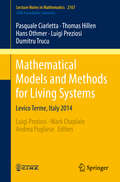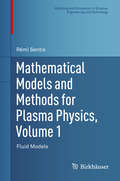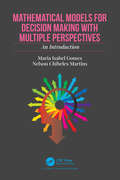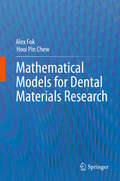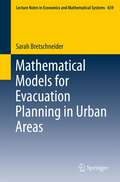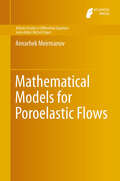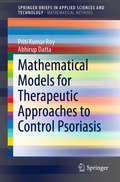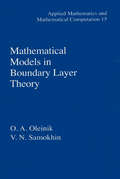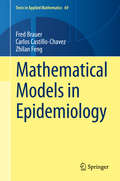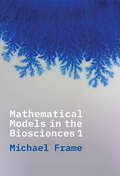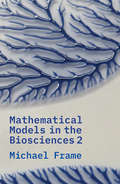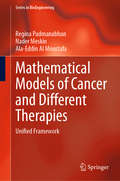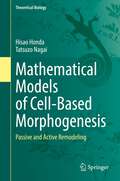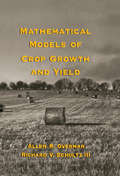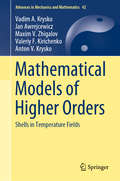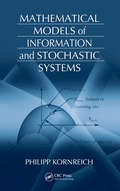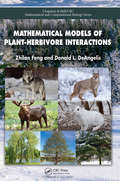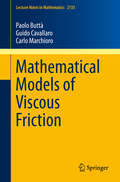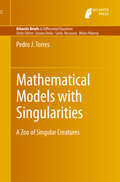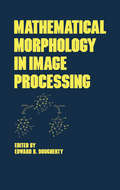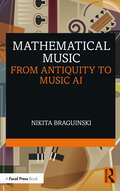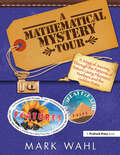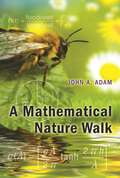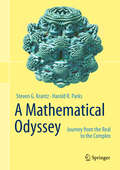- Table View
- List View
Mathematical Models and Methods for Living Systems
by Andrea Pugliese Mark Chaplain Dumitru Truculuigi Preziosi Luigi Preziosi Hans Othmer Thomas Hillen Pasquale CiarlettaThe aim of these lecture notes is to give an introduction to several mathematical models and methods that can be used to describe the behaviour of living systems. This emerging field of application intrinsically requires the handling of phenomena occurring at different spatial scales and hence the use of multiscale methods. Modelling and simulating the mechanisms that cells use to move, self-organise and develop in tissues is not only fundamental to an understanding of embryonic development, but is also relevant in tissue engineering and in other environmental and industrial processes involving the growth and homeostasis of biological systems. Growth and organization processes are also important in many tissue degeneration and regeneration processes, such as tumour growth, tissue vascularization, heart and muscle functionality, and cardio-vascular diseases.
Mathematical Models and Methods for Plasma Physics, Volume 1
by Rémi SentisThis monograph is dedicated to the derivation and analysis of fluid models occurring in plasma physics. It focuses on models involving quasi-neutrality approximation, problems related to laser propagation in a plasma, and coupling plasma waves and electromagnetic waves. Applied mathematicians will find a stimulating introduction to the world of plasma physics and a few open problems that are mathematically rich. Physicists who may be overwhelmed by the abundance of models and uncertain of their underlying assumptions will find basic mathematical properties of the related systems of partial differential equations. A planned second volume will be devoted to kinetic models. First and foremost, this book mathematically derives certain common fluid models from more general models. Although some of these derivations may be well known to physicists, it is important to highlight the assumptions underlying the derivations and to realize that some seemingly simple approximations turn out to be more complicated than they look. Such approximations are justified using asymptotic analysis wherever possible. Furthermore, efficient simulations of multi-dimensional models require precise statements of the related systems of partial differential equations along with appropriate boundary conditions. Some mathematical properties of these systems are presented which offer hints to those using numerical methods, although numerics is not the primary focus of the book.
Mathematical Models for Decision Making with Multiple Perspectives: An Introduction
by Maria Isabel Gomes Nelson Chibeles MartinsThis book brings together, in a single volume, the fields of multicriteria decision making and multiobjective optimization that are traditionally covered separately. Both fields have in common the presence of multiple perspectives of looking at and evaluating decisions to be taken but they differ in the number of available alternatives. Multicriteria approaches deal with decision processes where a finite number of alternatives have to be evaluated while, in multiobjective optimization, this number is infinite and the space of alternatives continuous. This book is written for students of applied mathematics, engineering, and economics and management, with no assumed previous knowledge on the subject, as well as for practitioners in industry looking for techniques to support decision making. The mathematical formalism is very low, so that all materials are accessible to most readers. Nonetheless, a rich bibliography allows interested readers to access more technical literature. The textbook is organized in eleven chapters, each corresponding to a class of about two hours. A comprehensive set of examples is presented, allowing for a didactic approach when presenting the methodologies. Each chapter ends with exercises that are designed to develop problem-solving skills and to promote concepts retention.
Mathematical Models for Dental Materials Research
by Alex Fok Hooi Pin ChewThis book presents a mechanistic approach—mathematical modeling—for carrying out dental materials research. This approach allows researchers to go beyond the null hypothesis and obtain a solution that is more general and therefore predictive for conditions other than those considered in a study. Hence it can be used either on its own or to complement the commonly used statistical approach. Through a series of practical problems with wide-ranging application, the reader will be guided on:How to construct a mathematical model for the behavior of dental materials by making informed assumptions of the physical, chemical, or mechanical situationHow to simplify the model by making suitable simplificationsHow to calibrate the model by calculating the values of key parameters using experimental resultsHow to refine the model when there are discrepancies between predictions and experimentsOnly elementary calculus is required to follow the examples and all the problems can be solved by using MS Excel© spreadsheets.This is an ideal book for dental materials researchers without a strong mathematical background who are interested in applying a more mechanistic approach to their research to give deeper insight into the problem at hand. Advance praise for Mathematical Models for Dental Materials Research:“This is a nice addition for research students on how to conduct their work and how to manage data analysis. It brings together a number of important aspects of dental materials investigations which has been missing in the literature. The practical examples make it much easier to understand.” – Michael F. Burrow, Clinical Professor in Prosthodontics, The University of Hong Kong“The great strengths of this volume are the real world examples of dental materials research in the successive chapters. In turn, this is an outcome of the outstanding expertise of both authors. I warmly recommend this book to the dental biomaterials community worldwide.” – David C. Watts, Professor of Biomaterials Science, University of Manchester, UK
Mathematical Models for Evacuation Planning in Urban Areas
by Sarah BretschneiderDisasters like floods, hurricanes, chemical or nuclear accidents may cause the necessity to evacuate the affected area. The evacuation of the urban area needs to be planned carefully. One issue is the reorganization of the traffic routing. Congested urban areas have usually complex street networks that are composed of many intersections with streets connecting them. The population density of a congested urban area is usually high and the street network is already used to capacity during rush hour traffic. The considered problem of this work is the reorganization of the traffic routing of an urban area for the case of an emergency mass evacuation. Especially aspects of the evacuation like safety, avoidance of delays and the total system travel time are taken into account. Combinatorial and graph theoretical aspects are adapted for the evacuation problem and highlight issues concerning especially conflicts within intersections. This work gives an extensive summary of literature of evacuation of urban areas. Mixed-integer linear programming models are developed for evacuation problems and heuristic algorithms are provided and tested.?
Mathematical Models for Poroelastic Flows
by Anvarbek MeirmanovThe book is devoted to rigorous derivation of macroscopic mathematical models as a homogenization of exact mathematical models at the microscopic level. The idea is quite natural: one first must describe the joint motion of the elastic skeleton and the fluid in pores at the microscopic level by means of classical continuum mechanics, and then use homogenization to find appropriate approximation models (homogenized equations). The Navier-Stokes equations still hold at this scale of the pore size in the order of 5 - 15 microns. Thus, as we have mentioned above, the macroscopic mathematical models obtained are still within the limits of physical applicability. These mathematical models describe different physical processes of liquid filtration and acoustics in poroelastic media, such as isothermal or non-isothermal filtration, hydraulic shock, isothermal or non-isothermal acoustics, diffusion-convection, filtration and acoustics in composite media or in porous fractured reservoirs. Our research is based upon the Nguetseng two-scale convergent method.
Mathematical Models for Therapeutic Approaches to Control Psoriasis (SpringerBriefs in Applied Sciences and Technology)
by Priti Kumar Roy Abhirup DattaThis book discusses several mathematical models highlighting the disease dynamics of psoriasis and its control. It explains the control of keratinocyte concentration through a negative feedback mechanism and the effect of including a realistic time delay in that system. The effect of cytokine release is described in a mathematical model of psoriasis and further elucidated in two different mathematical pathways: the ordinary differential equation model system, and the fractional-order differential equation model system. The book also identifies the role of CD8+ T-cells in psoriasis by investigating the interaction between dendritic cells and CD8+ T-cells. Presenting an approach to control the fractional-order system to prevent excess production of keratinocyte cell population, the book is intended for researchers and scientists in the field of applied mathematics, health informatics, applied statistics and qualitative public health, as well as bio-mathematicians interested in the mathematical modeling of autoimmune diseases like psoriasis.
Mathematical Models in Boundary Layer Theory (Applied Mathematics Ser. #15)
by V.N. SamokhinSince Prandtl first suggested it in 1904, boundary layer theory has become a fundamental aspect of fluid dynamics. Although a vast literature exists for theoretical and experimental aspects of the theory, for the most part, mathematical studies can be found only in separate, scattered articles. Mathematical Models in Boundary Layer Theory offers the first systematic exposition of the mathematical methods and main results of the theory.Beginning with the basics, the authors detail the techniques and results that reveal the nature of the equations that govern the flow within boundary layers and ultimately describe the laws underlying the motion of fluids with small viscosity. They investigate the questions of existence and uniqueness of solutions, the stability of solutions with respect to perturbations, and the qualitative behavior of solutions and their asymptotics. Of particular importance for applications, they present methods for an approximate solution of the Prandtl system and a subsequent evaluation of the rate of convergence of the approximations to the exact solution. Written by the world's foremost experts on the subject, Mathematical Models in Boundary Layer Theory provides the opportunity to explore its mathematical studies and their importance to the nonlinear theory of viscous and electrically conducting flows, the theory of heat and mass transfer, and the dynamics of reactive and muliphase media. With the theory's importance to a wide variety of applications, applied mathematicians-especially those in fluid dynamics-along with engineers of aeronautical and ship design will undoubtedly welcome this authoritative, state-of-the-art treatise.
Mathematical Models in Epidemiology (Texts in Applied Mathematics #69)
by Carlos Castillo-Chavez Fred Brauer Zhilan FengThe book is a comprehensive, self-contained introduction to the mathematical modeling and analysis of disease transmission models. It includes (i) an introduction to the main concepts of compartmental models including models with heterogeneous mixing of individuals and models for vector-transmitted diseases, (ii) a detailed analysis of models for important specific diseases, including tuberculosis, HIV/AIDS, influenza, Ebola virus disease, malaria, dengue fever and the Zika virus, (iii) an introduction to more advanced mathematical topics, including age structure, spatial structure, and mobility, and (iv) some challenges and opportunities for the future.There are exercises of varying degrees of difficulty, and projects leading to new research directions. For the benefit of public health professionals whose contact with mathematics may not be recent, there is an appendix covering the necessary mathematical background. There are indications which sections require a strong mathematical background so that the book can be useful for both mathematical modelers and public health professionals.
Mathematical Models in the Biosciences I
by Michael FrameAn award-winning professor’s introduction to essential concepts of calculus and mathematical modeling for students in the biosciences This is the first of a two-part series exploring essential concepts of calculus in the context of biological systems. Michael Frame covers essential ideas and theories of basic calculus and probability while providing examples of how they apply to subjects like chemotherapy and tumor growth, chemical diffusion, allometric scaling, predator-prey relations, and nerve impulses. Based on the author’s calculus class at Yale University, the book makes concepts of calculus more relatable for science majors and premedical students.
Mathematical Models in the Biosciences II
by Michael FrameVolume Two of an award-winning professor&’s introduction to essential concepts of calculus and mathematical modeling for students in the biosciences This is the second of a two-part series exploring essential concepts of calculus in the context of biological systems. Building on the essential ideas and theories of basic calculus taught in Mathematical Models in the Biosciences I, this book focuses on epidemiological models, mathematical foundations of virus and antiviral dynamics, ion channel models and cardiac arrhythmias, vector calculus and applications, and evolutionary models of disease. It also develops differential equations and stochastic models of many biomedical processes, as well as virus dynamics, the Clancy-Rudy model to determine the genetic basis of cardiac arrhythmias, and a sketch of some systems biology. Based on the author&’s calculus class at Yale, the book makes concepts of calculus less abstract and more relatable for science majors and premedical students.
Mathematical Models of Cancer and Different Therapies: Unified Framework (Series in BioEngineering)
by Regina Padmanabhan Nader Meskin Ala-Eddin Al MoustafaThis book provides a unified framework for various currently available mathematical models that are used to analyze progression and regression in cancer development, and to predict its dynamics with respect to therapeutic interventions. Accurate and reliable model representations of cancer dynamics are milestones in the field of cancer research. Mathematical modeling approaches are becoming increasingly common in cancer research, as these quantitative approaches can help to validate hypotheses concerning cancer dynamics and thus elucidate the complexly interlaced mechanisms involved. Even though the related conceptual and technical information is growing at an exponential rate, the application of said information and realization of useful healthcare devices are lagging behind.In order to remedy this discrepancy, more interdisciplinary research works and course curricula need to be introduced in academic, industrial, and clinical organizations alike. To that end, this book reformulates most of the existing mathematical models as special cases of a general model, allowing readers to easily get an overall idea of cancer dynamics and its modeling. Moreover, the book will help bridge the gap between biologists and engineers, as it brings together cancer dynamics, the main steps involved in mathematical modeling, and control strategies developed for cancer management. This also allows readers in both medical and engineering fields to compare and contrast all the therapy-based models developed to date using a single source, and to identify unexplored research directions.
Mathematical Models of Cell-Based Morphogenesis: Passive and Active Remodeling (Theoretical Biology)
by Hisao Honda Tatsuzo NagaiThis book describes the shape formation of living organisms using mathematical models. Genes are deeply related to the shape of living organisms, and elucidation of a pathway of shape formation from genes is one of the fundamental problems in biology. Mathematical cell models are indispensable tools to elucidate this problem. The book introduces two mathematical cell models, the cell center model and the vertex model, with their applications. The cell center model is applied to elucidate the formation of neat cell arrangements in epidermis, cell patterns consisting of heterogeneous-sized cells, capillary networks, and the branching patterns of blood vessels. The vertex model is applied to elucidate the wound healing mechanisms of the epithelium and ordered pattern formation involving apoptosis. Pattern formation with differential cell adhesion is also described. The vertex model is then extended from a two-dimensional (2D) to a three-dimensional (3D) model. A cell aggregate involving a large cavity is described to explain the development of the mammalian blastocyst or the formation of an epithelial vesicle. Epithelial tissues and the polarity formation process of the epithelium are also explained. The vertex model also recapitulates active remodeling of tissues and describes the twisting of tissue that contributes to understanding the cardiac loop formation of the embryonic tube. The book showcases that mathematical cell models are indispensable tools to understand the shape formation of living organisms. Successful contribution of the mathematical cell models means that the remodeling of collective cells is self-construction. Examining the successive iterations of self-constructions leads to understanding the remarkable and mysterious morphogenesis that occurs during the development of living organisms. The intended readers of this book are not only theoretical or mathematical biologists, but also experimental and general biologists, including undergraduate and postgraduate students who are interested in the relationship between genes and morphogenesis.
Mathematical Models of Crop Growth and Yield (Books In Soils, Plants, And The Environment Ser. #Vol. 91)
by Allen R. Overman Richard V. Scholtz IIIHighlighting effective, analytical functions that have been found useful for the comparison of alternative management techniques to maximize water and nutrient resources, this reference describes the application of viable mathematical models in data analysis to increase crop growth and yields. Featuring solutions to various differential equations,
Mathematical Models of Higher Orders: Shells In Temperature Fields (Advances in Mechanics and Mathematics #42)
by Jan Awrejcewicz Vadim A. Krysko Maxim V. Zhigalov Valeriy F. Kirichenko Anton V. KryskoThis book offers a valuable methodological approach to the state-of-the-art of the classical plate/shell mathematical models, exemplifying the vast range of mathematical models of nonlinear dynamics and statics of continuous mechanical structural members. The main objective highlights the need for further study of the classical problem of shell dynamics consisting of mathematical modeling, derivation of nonlinear PDEs, and of finding their solutions based on the development of new and effective numerical techniques. The book is designed for a broad readership of graduate students in mechanical and civil engineering, applied mathematics, and physics, as well as to researchers and professionals interested in a rigorous and comprehensive study of modeling non-linear phenomena governed by PDEs.
Mathematical Models of Information and Stochastic Systems
by Philipp KornreichFrom ancient soothsayers and astrologists to today’s pollsters and economists, probability theory has long been used to predict the future on the basis of past and present knowledge. Mathematical Models of Information and Stochastic Systems shows that the amount of knowledge about a system plays an important role in the mathematical models used to foretell the future of the system. It explains how this known quantity of information is used to derive a system’s probabilistic properties. After an introduction, the book presents several basic principles that are employed in the remainder of the text to develop useful examples of probability theory. It examines both discrete and continuous distribution functions and random variables, followed by a chapter on the average values, correlations, and covariances of functions of variables as well as the probabilistic mathematical model of quantum mechanics. The author then explores the concepts of randomness and entropy and derives various discrete probabilities and continuous probability density functions from what is known about a particular stochastic system. The final chapters discuss information of discrete and continuous systems, time-dependent stochastic processes, data analysis, and chaotic systems and fractals. By building a range of probability distributions based on prior knowledge of the problem, this classroom-tested text illustrates how to predict the behavior of diverse systems. A solutions manual is available for qualifying instructors.
Mathematical Models of Plant-Herbivore Interactions (Chapman & Hall/CRC Mathematical Biology Series)
by Zhilan Feng Donald DeAngelisMathematical Models of Plant-Herbivore Interactions addresses mathematical models in the study of practical questions in ecology, particularly factors that affect herbivory, including plant defense, herbivore natural enemies, and adaptive herbivory, as well as the effects of these on plant community dynamics. <P><P> The result of extensive research on the use of mathematical modeling to investigate the effects of plant defenses on plant-herbivore dynamics, this book describes a toxin-determined functional response model (TDFRM) that helps explains field observations of these interactions. <P><P> This book is intended for graduate students and researchers interested in mathematical biology and ecology.
Mathematical Models of Viscous Friction
by Paolo Buttà Guido Cavallaro Carlo MarchioroIn this monograph we present a review of a number of recent results on the motion of a classical body immersed in an infinitely extended medium and subjected to the action of an external force. We investigate this topic in the framework of mathematical physics by focusing mainly on the class of purely Hamiltonian systems, for which very few results are available. We discuss two cases: when the medium is a gas and when it is a fluid. In the first case, the aim is to obtain microscopic models of viscous friction. In the second, we seek to underline some non-trivial features of the motion. Far from giving a general survey on the subject, which is very rich and complex from both a phenomenological and theoretical point of view, we focus on some fairly simple models that can be studied rigorously, thus providing a first step towards a mathematical description of viscous friction. In some cases, we restrict ourselves to studying the problem at a heuristic level, or we present the main ideas, discussing only some aspects of the proof if it is prohibitively technical. This book is principally addressed to researchers or PhD students who are interested in this or related fields of mathematical physics.
Mathematical Models with Applications
by Ralph Bertelle Judith Bloch Roy CameronNIMAC-sourced textbook
Mathematical Models with Singularities
by Pedro J. TorresThe book aims to provide an unifying view of a variety (a 'zoo') of mathematical models with some kind of singular nonlinearity, in the sense that it becomes infinite when the state variable approaches a certain point. Up to 11 different concrete models are analyzed in separate chapters. Each chapter starts with a discussion of the basic model and its physical significance. Then the main results and typical proofs are outlined, followed by open problems. Each chapter is closed by a suitable list of references. The book may serve as a guide for researchers interested in the modelling of real world processes.
Mathematical Morphology in Image Processing (Optical Science and Engineering #1)
by Edward DoughertyPresents the statistical analysis of morphological filters and their automatic optical design, the development of morphological features for image signatures, and the design of efficient morphological algorithms. Extends the morphological paradigm to include other branches of science and mathematics.;This book is designed to be of interest to optical, electrical and electronics, and electro-optic engineers, including image processing, signal processing, machine vision, and computer vision engineers, applied mathematicians, image analysts and scientists and graduate-level students in image processing and mathematical morphology courses.
Mathematical Music: From Antiquity to Music AI
by Nikita BraguinskiMathematical Music offers a concise and easily accessible history of how mathematics was used to create music. The story presented in this short, engaging volume ranges from ratios in antiquity to random combinations in the 17th century, 20th-century statistics, and contemporary artificial intelligence. This book provides a fascinating panorama of the gradual mechanization of thought processes involved in the creation of music. How did Baroque authors envision a composition system based on combinatorics? What was it like to create musical algorithms at the beginning of the 20th century, before the computer became a reality? And how does this all explain today’s use of artificial intelligence and machine learning in music? In addition to discussing the history and the present state of mathematical music, Braguinski also takes a look at what possibilities the near future of music AI might hold for listeners, musicians, and the society. Grounded in research findings from musicology and the history of technology, and written for the non-specialist general audience, this book helps both student and professional readers to make sense of today’s music AI by situating it in a continuous historical context.
A Mathematical Mystery Tour: Higher-Thinking Math Tasks (Grades 5-12)
by Mark WahlA Mathematical Mystery Tour has been used by thousands of students and has inspired adults to greater appreciation of the secret number language of nature. It is multidisciplinary, visual, and hands-on, practicing skills while also requiring deep math thinking. The activities are reproducible and each is accompanied with informational teacher pages giving answers, historical notes, teacher suggestions, and activity extensions.Let this geographically alive Mystery Tour integrate math with art, science, philosophy, history, social studies, and language arts. The use of the calculator, geometric construction, metric measurement, problem solving, formulating results, building models and making inferences is woven throughout the book.Each book purchase includes a link to a downloadable student newspaper, the Mathematical Mystery Tour Guide, coordinated with the book content. It is capable of being broken up into various assignments and handed out as print or sent whole electronically to each student. It is filled with games, riddles, dramatic historical information, crosswords, provocative questions, and additional math thought activities.
A Mathematical Nature Walk
by John AdamHow heavy is that cloud? Why can you see farther in rain than in fog? Why are the droplets on that spider web spaced apart so evenly? If you have ever asked questions like these while outdoors, and wondered how you might figure out the answers, this is a book for you. An entertaining and informative collection of fascinating puzzles from the natural world around us, A Mathematical Nature Walk will delight anyone who loves nature or math or both. John Adam presents ninety-six questions about many common natural phenomena--and a few uncommon ones--and then shows how to answer them using mostly basic mathematics. Can you weigh a pumpkin just by carefully looking at it? Why can you see farther in rain than in fog? What causes the variations in the colors of butterfly wings, bird feathers, and oil slicks? And why are large haystacks prone to spontaneous combustion? These are just a few of the questions you'll find inside. Many of the problems are illustrated with photos and drawings, and the book also has answers, a glossary of terms, and a list of some of the patterns found in nature. About a quarter of the questions can be answered with arithmetic, and many of the rest require only precalculus. But regardless of math background, readers will learn from the informal descriptions of the problems and gain a new appreciation of the beauty of nature and the mathematics that lies behind it.
A Mathematical Odyssey: Journey from the Real to the Complex
by Harold R. Parks Steven G. KrantzMathematics is a poem. It is a lucid, sensual, precise exposition of beautiful ideas directed to specific goals. It is worthwhile to have as broad a cross-section of mankind as possible be conversant with what goes on in mathematics. Just as everyone knows that the Internet is a powerful and important tool for communication, so everyone should know that the Poincaré conjecture gives us important information about the shape of our universe. Just as every responsible citizen realizes that the mass-production automobile was pioneered by Henry Ford, so everyone should know that the P/NP problem has implications for security and data manipulation that will affect everyone. This book endeavors to tell the story of the modern impact of mathematics, of its trials and triumphs and insights, in language that can be appreciated by a broad audience. It endeavors to show what mathematics means for our lives, how it impacts all of us, and what new thoughts it should cause us to entertain. It introduces new vistas of mathematical ideas and shares the excitement of new ideas freshly minted. It discusses the significance and impact of these ideas, and gives them meaning that will travel well and cause people to reconsider their place in the universe. Mathematics is one of mankind's oldest disciplines. Along with philosophy, it has shaped the very modus of human thought. And it continues to do so. To be unaware of modern mathematics is to miss out on a large slice of life. It is to be left out of essential modern developments. We want to address this point, and do something about it. This is a book to make mathematics exciting for people of all interests and all walks of life. Mathematics is exhilarating, it is ennobling, it is uplifting, and it is fascinating. We want to show people this part of our world, and to get them to travel new paths.
